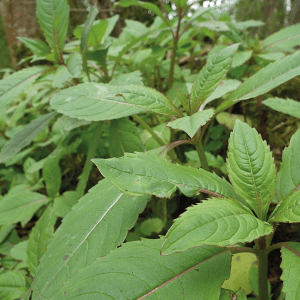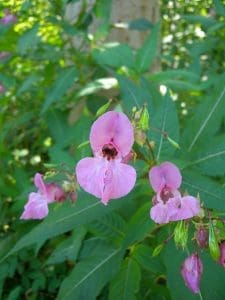Himalayan Balsam / Spring / Summer / Edible
Himalayan Balsam is an incredibly invasive species that is often found spreading up riverside edges, however, it’s also a brilliant edible and has edible, leaves, shoots flower & seeds..
Common names
Himalayan Balsam, Indian Balsam, Bobby Tops, Copper Tops, Gnome’s Hatstand, Ornamental Jewelweed, Policeman’s Helmet, Kiss-me-on-the-Mountain
Botanical name
Impatiens glandulifera
Meaning of botanical name
Impatiens is from the Latin for impatient, referring to how the seed pods burst open. Glandulifera means to have flowers with glands
Known hazards
This plant is a non-native invasive and eradication programmes are in place in many parts of the UK. Some people have displayed allergies to Himalayan Balsam’s pollen.
Could be confused with…
The Plant is very distinctive, so it would be difficult to confuse with other species. There’s potential if you just had the flowers and nothing else on the plant you could confuse it with foxgloves, however foxglove leaves are hair which balsam isn’t
Food plant of
Very popular with pollinators. However, the big showy flowers distract from native species.
Range and distribution
Invasive and established across the globe
Habitat
Most commonly found along waterways, but can grow away from water. It was introduced to the UK in 1839 as a garden plant
Physical characteristics of Himalayan Balsam
Stems
Tall stems reaching up to 2m in height. The stalk is has a reddish tinge.

Leaves
The Leaves are Lanceolate with serrated edges and redish veins running through it.

Flowers
The flowers are pink and shaped like helmets

Seeds
The seed pods explode when gently touched.

Edible uses of Himalayan Balsam
The seedings, young shoots, leaves, flowers and seeds are all edible. The seeds give a nice crunch and texture to salads, while the flowers and young shoots can be made into jams
Miscellaneous
It is a relative of the Busy Lizzie. The hollow stalks can be used as a straw.
Tips and Observations
When harvesting the seeds, carefully place a carrier bag over the tops of the plants and close the neck of the bag with your hand. This action alone should be enough to cause the seed heads to explode and catch all the seeds. Remember to tip the bag right way up before removing your hand.
Important Point on Balsam
Notes below from:
Curtis Wright
Administrative Officer
Pilot NNS Inspectorate
National Wildlife Management Centre (NWMC)
Animal Plant Health Agency (APHA)
Telephone: 07920516559
Address: York Biotech Campus, APHA, National Wildlife Management Centre (NWMC), Room 12G35, Sand Hutton, York, YO41 1LZ
The transportation of seeds or whole plants is an offence under the Invasive Alien Species (Enforcement and Permitting) Order 2019 in England and Wales and Section 14AA of the Wildlife and Countryside Act in Scotland. This means that no seeds or plants should be removed from the site where they currently grow, and sowing seeds or planting elsewhere either deliberately or accidentally would be a particularly serious offence.





